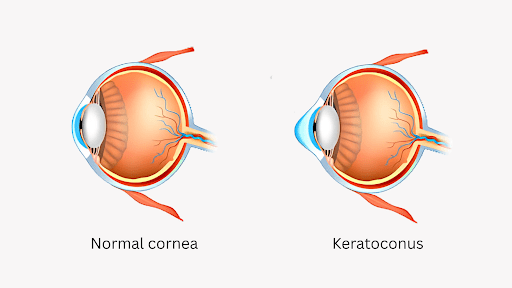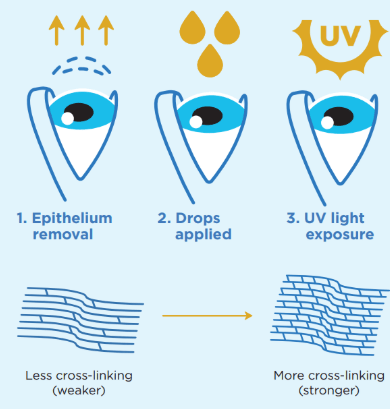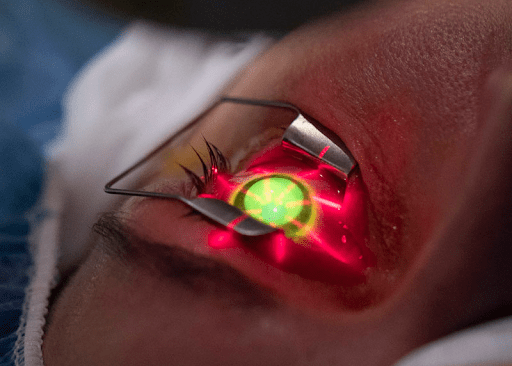Corneal cross-linking (CXL) for the eye is a surgical treatment to treat conditions that affect the cornea, the transparent surface of the eye. This procedure strengthens the collagen fibers within the cornea to prevent further damage, stabilize the shape of the eye, and, in some cases, improve vision.
Who can Benefit from Corneal Cross-Linking?
Corneal cross-linking is most commonly used to halt the progression of keratoconus, but it may also be beneficial for other corneal conditions, such as corneal ectasia, whereas the cornea becomes too thin and begins to bulge.
Here are some people who may benefit from corneal cross-linking:
- Keratoconus
- Post-LASIK ectasia
- Progressive corneal thinning
- Alternative to corneal transplant

How Does Corneal Cross-Linking Work?
Collagen is a protein that provides strength and structure to the cornea. In conditions like keratoconus, the collagen in the cornea becomes weak and less organized, causing the cornea to thin and bulge.
A photosensitizing agent, riboflavin drops (vitamin B2), is applied to the cornea. Riboflavin works as a “bridge” to strengthen the collagen structure, stabilizing the cornea and making it more resistant to further deformation.
The result is a stronger, more rigid cornea, which can help prevent the progression of keratoconus and other corneal thinning disease.

Source: Boston Vision
What to Expect During the Corneal Cross-Linking Procedure
Corneal cross-linking is typically an outpatient procedure, meaning patients can go home the same day. Here’s what you can expect during the procedure:
- Numbing the Eye: Before the procedure begins, topical anesthetic eye drops will be applied to ensure that you are comfortable and pain-free during the treatment.
- Riboflavin Application: The ophthalmologist will apply riboflavin (vitamin B2) drops to the cornea.
- UV Light Exposure: The cornea will be exposed to ultraviolet (UV) light for a set period, around 30 minutes. The UV light activates the riboflavin and initiates the collagen cross-linking process.
- Bandage Contact Lens Application: This helps the cornea to heal.
- Post Operative Care: Antibiotic and steroid drops will be given to help your eye heal.

Source: Cleveland Clinic
Benefits of Corneal Cross-Linking for the Eye
Corneal cross-linking offers several benefits, particularly for individuals with keratoconus and other corneal conditions:
- Prevents Disease Progression: It can prevent further vision deterioration and might reduce the need for a corneal transplant.
- Minimally Invasive: Unlike a corneal transplant, collagen cross-linking is a minimally invasive procedure with a relatively quick recovery time. Most patients return to their normal activities within a few days to weeks.
If you or someone you know is dealing with corneal disease, it’s important to talk to an ophthalmologist about the benefits and risks of CXL. With early detection and appropriate treatment, you can help protect your vision for years to come.
The cornea specialists available in OasisEye Specialists include Dr Vanitha Ratnalingam who is based in Kuala Lumpur and Penang; and Dr K John Mathen who is based in Kuala Lumpur.
FAQs
During the procedure, you will receive numbing eye drops, so there is little to no pain.
The main goal is to halt progression, not necessarily improve vision.
However, some patients experience mild flattening of the cornea, which can lead to slight vision improvement over time.
No. CXL stabilizes the cornea and slows or stops further worsening but does not reverse keratoconus. Additional treatments, like contact lenses, glasses, or intracorneal ring segments, may still be needed.
Common side effects include:
- Temporary blurry vision.
- Eye discomfort or dryness.
- Light sensitivity.
Rare but serious risks include:
- Infection.
- Corneal haze or scarring.
- Delayed healing.
- No rubbing the eyes.
- Avoid swimming, eye makeup, and dusty environments until the doctor clears you.
- Use prescribed antibiotic and anti-inflammatory drops exactly as instructed.
Yes. However, the procedure can stabilize your condition and prevent the need for a corneal transplant.






